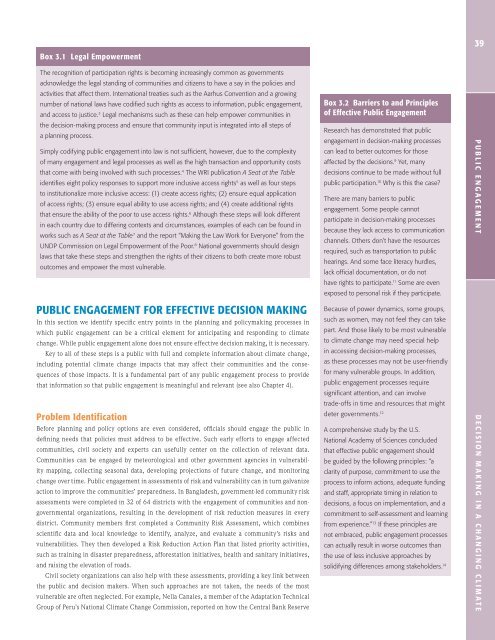Decision Making in a Changing Climate - World Resources Institute
Decision Making in a Changing Climate - World Resources Institute
Decision Making in a Changing Climate - World Resources Institute
- No tags were found...
You also want an ePaper? Increase the reach of your titles
YUMPU automatically turns print PDFs into web optimized ePapers that Google loves.
Box 3.1 Legal Empowerment39The recognition of participation rights is becom<strong>in</strong>g <strong>in</strong>creas<strong>in</strong>gly common as governmentsacknowledge the legal stand<strong>in</strong>g of communities and citizens to have a say <strong>in</strong> the policies andactivities that affect them. International treaties such as the Aarhus Convention and a grow<strong>in</strong>gnumber of national laws have codified such rights as access to <strong>in</strong>formation, public engagement,and access to justice. 3 Legal mechanisms such as these can help empower communities <strong>in</strong>the decision-mak<strong>in</strong>g process and ensure that community <strong>in</strong>put is <strong>in</strong>tegrated <strong>in</strong>to all steps ofa plann<strong>in</strong>g process.Simply codify<strong>in</strong>g public engagement <strong>in</strong>to law is not sufficient, however, due to the complexityof many engagement and legal processes as well as the high transaction and opportunity coststhat come with be<strong>in</strong>g <strong>in</strong>volved with such processes. 4 The WRI publication A Seat at the Tableidentifies eight policy responses to support more <strong>in</strong>clusive access rights 5 as well as four stepsto <strong>in</strong>stitutionalize more <strong>in</strong>clusive access: (1) create access rights; (2) ensure equal applicationof access rights; (3) ensure equal ability to use access rights; and (4) create additional rightsthat ensure the ability of the poor to use access rights. 6 Although these steps will look different<strong>in</strong> each country due to differ<strong>in</strong>g contexts and circumstances, examples of each can be found <strong>in</strong>works such as A Seat at the Table 7 and the report “<strong>Mak<strong>in</strong>g</strong> the Law Work for Everyone” from theUNDP Commission on Legal Empowerment of the Poor. 8 National governments should designlaws that take these steps and strengthen the rights of their citizens to both create more robustoutcomes and empower the most vulnerable.Public Engagement for Effective <strong>Decision</strong> <strong>Mak<strong>in</strong>g</strong>In this section we identify specific entry po<strong>in</strong>ts <strong>in</strong> the plann<strong>in</strong>g and policymak<strong>in</strong>g processes <strong>in</strong>which public engagement can be a critical element for anticipat<strong>in</strong>g and respond<strong>in</strong>g to climatechange. While public engagement alone does not ensure effective decision mak<strong>in</strong>g, it is necessary.Key to all of these steps is a public with full and complete <strong>in</strong>formation about climate change,<strong>in</strong>clud<strong>in</strong>g potential climate change impacts that may affect their communities and the consequencesof those impacts. It is a fundamental part of any public engagement process to providethat <strong>in</strong>formation so that public engagement is mean<strong>in</strong>gful and relevant (see also Chapter 4).Problem IdentificationBefore plann<strong>in</strong>g and policy options are even considered, officials should engage the public <strong>in</strong>def<strong>in</strong><strong>in</strong>g needs that policies must address to be effective. Such early efforts to engage affectedcommunities, civil society and experts can usefully center on the collection of relevant data.Communities can be engaged by meteorological and other government agencies <strong>in</strong> vulnerabilitymapp<strong>in</strong>g, collect<strong>in</strong>g seasonal data, develop<strong>in</strong>g projections of future change, and monitor<strong>in</strong>gchange over time. Public engagement <strong>in</strong> assessments of risk and vulnerability can <strong>in</strong> turn galvanizeaction to improve the communities’ preparedness. In Bangladesh, government-led community riskassessments were completed <strong>in</strong> 32 of 64 districts with the engagement of communities and nongovernmentalorganizations, result<strong>in</strong>g <strong>in</strong> the development of risk reduction measures <strong>in</strong> everydistrict. Community members first completed a Community Risk Assessment, which comb<strong>in</strong>esscientific data and local knowledge to identify, analyze, and evaluate a community’s risks andvulnerabilities. They then developed a Risk Reduction Action Plan that listed priority activities,such as tra<strong>in</strong><strong>in</strong>g <strong>in</strong> disaster preparedness, afforestation <strong>in</strong>itiatives, health and sanitary <strong>in</strong>itiatives,and rais<strong>in</strong>g the elevation of roads.Civil society organizations can also help with these assessments, provid<strong>in</strong>g a key l<strong>in</strong>k betweenthe public and decision makers. When such approaches are not taken, the needs of the mostvulnerable are often neglected. For example, Nella Canales, a member of the Adaptation TechnicalGroup of Peru’s National <strong>Climate</strong> Change Commission, reported on how the Central Bank ReserveBox 3.2 Barriers to and Pr<strong>in</strong>ciplesof Effective Public EngagementResearch has demonstrated that publicengagement <strong>in</strong> decision-mak<strong>in</strong>g processescan lead to better outcomes for thoseaffected by the decisions. 9 Yet, manydecisions cont<strong>in</strong>ue to be made without fullpublic participation. 10 Why is this the case?There are many barriers to publicengagement. Some people cannotparticipate <strong>in</strong> decision-mak<strong>in</strong>g processesbecause they lack access to communicationchannels. Others don’t have the resourcesrequired, such as transportation to publichear<strong>in</strong>gs. And some face literacy hurdles,lack official documentation, or do nothave rights to participate. 11 Some are evenexposed to personal risk if they participate.Because of power dynamics, some groups,such as women, may not feel they can takepart. And those likely to be most vulnerableto climate change may need special help<strong>in</strong> access<strong>in</strong>g decision-mak<strong>in</strong>g processes,as these processes may not be user-friendlyfor many vulnerable groups. In addition,public engagement processes requiresignificant attention, and can <strong>in</strong>volvetrade-offs <strong>in</strong> time and resources that mightdeter governments. 12A comprehensive study by the U.S.National Academy of Sciences concludedthat effective public engagement shouldbe guided by the follow<strong>in</strong>g pr<strong>in</strong>ciples: “aclarity of purpose, commitment to use theprocess to <strong>in</strong>form actions, adequate fund<strong>in</strong>gand staff, appropriate tim<strong>in</strong>g <strong>in</strong> relation todecisions, a focus on implementation, and acommitment to self-assessment and learn<strong>in</strong>gfrom experience.” 13 If these pr<strong>in</strong>ciples arenot embraced, public engagement processescan actually result <strong>in</strong> worse outcomes thanthe use of less <strong>in</strong>clusive approaches bysolidify<strong>in</strong>g differences among stakeholders. 14public Chapter engagement titledecision mak<strong>in</strong>g <strong>in</strong> a chang<strong>in</strong>g climate
















